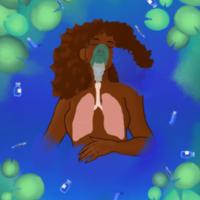covidcore, 2024
Title
covidcore, 2024
Subject
COVID-19 long-term syndrome
Description
Artist statement:
Given the extensive list of symptoms associated with COVID-19, I decided to emphasize the respiratory and cardiac aspects. As I brainstormed potential designs, it became clear that the artwork must incorporate lungs and a nebulizer. In light of the prevalent symptoms of breathlessness and coughing, I opted to connect the nebulizer tube to the trachea. To convey the idea that COVID-19 can rapidly worsen if left untreated, I depicted the subject submerged in water surrounded by moss and lily pads, resembling a lake. Additionally, I incorporated symbols of medical intervention such as vaccines, needles, and inhalers within the water. By submerging different parts of the subject's body, I aimed to evoke a sense of sinking, symbolizing the dire consequences of neglecting COVID-19 treatment.Medical description:
COVID-19 is caused by the SARS-Cov-2 virus transmitted through respiratory droplets. The virus enters the body and attaches to the ACE2 inhibitor on the cells and replicates and spreads throughout the body, triggering an immune response. This virus mainly targets the respiratory system and can cause acute respiratory distress syndrome. COVID-19 has a wide range of symptoms that can last weeks, months, or even years after infection. Some of the more common symptoms are fever, cough, and shortness of breath, but can extend to neurological, respiratory, digestive, and general symptoms. Some people, with severe COVID-19, may experience multi-organ effects or autoimmune conditions, making them more susceptible to developing new health conditions. In addition, mental health problems can arise from grief, loss, unresolved pain or fatigue, and PTSD. Patient education for Long-term COVID-19 derived from the misunderstanding that COVID-19 is just an acute illness without any long-term detriments. An evidence-based practice conducted by Roth et. al, suggests using figures such as ‘HOPE’ to guide patient education. This figure allows a holistic view including physical, behavioral, psychosocial, and spiritual components of their life. Moreover, another evidence-based practice journal by et. al states that long covid and its symptoms may be downplayed. Utilizing both articles, patient education should include some sort of tool facilitating the exploration of patient needs from physical to psyche as well as stressing the importance that long COVID does exist. Successful education explores the signs and symptoms listed above as well as practices to further explore patient concerns. Education should include that COVID-19 in itself may cause illness after the acute phase. Deep breathing exercises and the prone positioning can help expand lung perfusion. Physical therapy can help patients regain their strength and fitness after being ill. Oxygen will be provided, and nurses will monitor vital signs and may need to administer fluids to prevent dehydration. Over-the-counter medications like acetaminophen and ibuprofen can be given for mild symptoms. Finally, a personal medical management plan can be developed to improve the patient's quality of life.Creator
Madugba, Faith
Date
2024
Contributor
Gonzales, Juan Miguel; Thihlum, Lily; Leake, Alexia; Polanco, Alexis
Rights
In Copyright- This Item is protected by copyright and/or related rights.
Format
Digital illustration ; 8.5 x 11 in.
Citation
Madugba, Faith, “covidcore, 2024,” TWU Digital Exhibits, accessed September 18, 2024, http://exhibits.twu.edu/ex/items/show/293.
